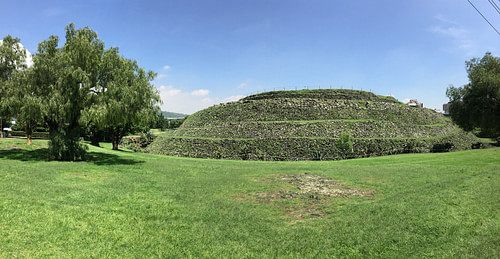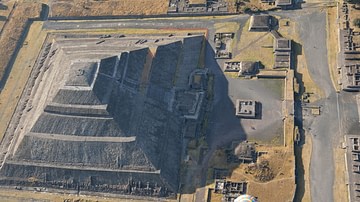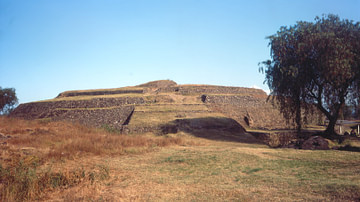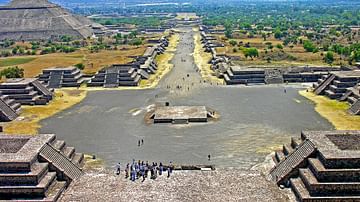
Cuicuilco is an ancient settlement site in central Mexico, now located in southern Mexico City. Prominent in the late pre-Classic period, around 500 BCE, it is noted for its large circular temple mound, one of the earliest monumental structures in ancient Mesoamerica and influential on many later pyramid monuments built by the Maya and Aztecs amongst others. Buried in several metres of lava and abandoned Cuicuilco remains one of the most enigmatic early urban centres in the Americas.
A Large Urban Centre
Cuicuilco was inhabited just at the period when Mesoamerican villages were transforming into larger population centres which would in turn become the great cities of the region in later centuries. At its height the town may have had a population of up to 20,000 people, its prosperity based on the fertile land in the surrounding lagoon basin of the Mexico Valley. Several small platform structures, houses, and plazas have been excavated at the site, which is estimated to have covered 400 ha (1,000 acres), demonstrating that it was one of the first large settlements in Mesoamerica.
The Temple Pyramid
The site of Cuicuilco is dominated today by the massive circular temple pyramid or mound. The structure was constructed sometime in the 5th century BCE (confirmed by radio-carbon dating). The earth, sand, and rubble mound is 135 metres (443 feet) in diameter at its base and 23 metres (75 feet) high. The total volume of the temple is 60,000 cubic metres (2 million cubic feet). It has four levels with inwardly sloping sides which decrease in size. The four levels were each faced with volcanic stone rocks and slabs fixed in place using a clay mortar. The construction of the temple mound was in two separate stages. First, two levels were built with a temple on the top level. This was likely an attempt to secure a dry and permanent platform above the floodplains below. In a second building programme, the mound was enlarged by adding another two higher levels, again with a temple on the top level.
The stone altar found by archaeologists on top of the pyramid was originally housed in a dual temple structure with a cone roof. Adding an extra four metres to the already impressive height of the temple, this structure was aligned with the sun on the equinox. The altar bears traces of red pigment (cinnabar), suggesting its purpose was for sacrifices in religious ceremonies. Excavated next to this altar was a ceramic figurine, dating to c. 300 BCE, representing an old man carrying a brazier on his back. The historian R.E. Townsend suggests this may indicate rituals at the altar involved fire. In later Mesoamerican cultures we know that priests were responsible for maintaining temple fires.
The top of the temple was accessed via a ramp and three flights of monumental staircases on the east side while the west side had four flights of steps. The circular form of the mound is very similar to later Huastec and Tarascan structures, and the layered monument with stairways is an early form of the large temple pyramids which would dominate such Mesoamerican sites as Teotihuacan, the great Maya cities, and the Aztec capital Tenochtitlan.
To the side of the temple mound are burial sites. Their excavation has revealed pottery, incense burners, and clay figurines of local manufacture. The figurines are typical of Mesoamerican art of all periods and represent human figures, animals, and birds. Standing females are the most common type, with details such as mouth and oval eyes deeply incised with a single line.
Destruction
Cuicuilco was devastated by a lava flow from the nearby Xitli volcano at the end of the pre-Classic period, perhaps around 200 BCE. Around 150 years later (or perhaps even c. 100 CE) there was another eruption and Cuicuilco was definitively abandoned leaving its neighbor Teotihuacan to dominate the region for the next 500 years. If the later date is accepted for the second eruption, then it is likely that more powerful Teotihuacan had already taken over Cuicuilco. The flow covered both the temple mound and the site's burial grounds in up to seven metres of lava making excavation impractical in most places. Nevertheless, parts of the site were excavated and its temple mound rediscovered in the 1920s CE.





